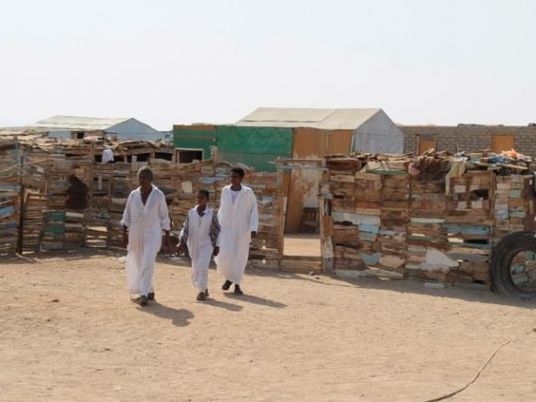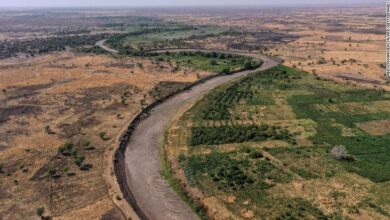
Controversy resurfaced on Saturday over remarks by Sudan’s President Omar al-Bashir to the London-based Asharq Al-Awsat about his country’s sovereignty over the Halayeb and Shalateen region which Egypt also claims.
As Bashir ruled out military confrontation with Egypt over the territory, more details are worth knowing about the crisis which goes back to the 20th century and remains unresolved as both sides grow more adamant in their right to the region.
Several facts about the dispute are rolled down in a study released by Al-Arabiya Institute for Studies:
1- Halayeb and Shalateen, 20,000 square kilometers on the Red Sea, lie at the borders between Egypt and Sudan. It is inhabited by tribes who have their historical roots at both countries, and whose existence before the demarcation of borders provides them with the freedom to move across the frontiers. Halayeb is Egypt’s southern gate on the Red Sea and maintains the importance of providing custom services for passers through Egypt-Sudan borders.
2- The region of Halayeb retains a strategic significance for both Egypt and Sudan. Egypt views it as its defensive wall on the Red Sea borders, while Sudan considers it an important factor for the preservation of its unity and political stability. All that is not to ignore the region’s economic and commercial importance for both countries.
3- The demarcation of the Halayeb and Shalateen took place when Egypt and Sudan where under British occupation. The Sudan Agreement was signed between Egypt and Britain on 19 January 1899. ًWhile Egypt was represented by, then, foreign minister Botrous Ghaly, Britain signed through its high commissioner in Egypt, Lord Cromer.
The agreement stipulated that the separating line between Egypt and Sudan was latitude 22 north. Shortly after, the agreed borders were slightly modified by Egypt’s Interior Ministry under the pretext of facilitating the movement of the Sudanese Beshariya and Egyptian Ababda tribes.
4- Some historical references reveal that the first time the border controversy over Halayeb occurred in January 1958, when Egypt submitted a memo to the Sudanese government rejecting a new Sudanese election law. Egypt argued that the draft violated the 1899 agreement on common borders as it counts the areas of Halayeb, Shalateen and northern Wadi Halfa as Sudanese constituencies. When Egypt claimed right to the Sudan-run areas north of latitude 22, it was the first time the dispute was declared.
Arguments on which Sudan bases its claim to Halayeb and Shalateen:
5- Sudan had already laid hands on those regions, having run them since the administrative modifications carried out by Egypt’s foreign ministry in June 1902. The changes were made after a panel composing Aswan’s governor, a representative of Egypt interior ministry, a Sudanese representative and another from Egypt’s frontier guards submitted a report stressing that the Halayeb and Shalateen are territories inhabited by Sudanese tribes.
6- Egypt had not objected to the status quo for years before Sudan gained independence on January 1956. According to international law principles, that position gives Sudan firm grounds for adhering to the aforementioned regions.
7- Sudan adopts the principle of maintaining borders inherited under occupation to embolden its argument. Sources reveal that a number of regional and international organizations, including the Organization of African Unity, guaranteed through its charters to the maintenance of borders acknowledged under occupation. Sudan also cites the African presidents and leaders conference, held in Cairo in 1964, which acknowledged the same principle.
8- Sudan argues that Egypt’s recognition of the independence of Sudan in 1956 did not involve any reservations concerning the borders.
Egypt’s argument in claiming title to Halayeb and Shalateen
9- Egypt maintains that the administrative modifications made to its borders with Sudan were officially implemented for humanitarian reasons, that is, to facilitate life for tribes living on both sides of the borders. Cairo believes the decisions were issued in response to requests by local officials at the disputed territories and were merely meant for those purposes.
10- Egypt rejects Sudan’s claim that it practiced actual sovereignty over the regions of Halayeb, Shalateen and Abu Ramad since 1902. It believes actual sovereignty should be obtained through peaceful means rather than protesting or disputing. Stances adopted by Egypt following Sudan’s electoral measures in relation to Halayeb and Shalateen in 1958 reveal that it had never agreed with those decisions. Egypt argues, stressing it had submitted several official objections to Sudan protesting those measures.
11- From an Egyptian perspective, running the Halayeb-Shalateen-Abu Ramad triangle casually does not provide Sudan with any sovereignty, and does not deny Egypt its historic, legal right based in the 1899 demarcation agreement.
12- Egypt also contends that Sudan ran the region when it was under occupation, which meant it lacked sovereignty as a state of recognized legal personality.
13- Egypt reiterates it had never signed any treaties or international agreements, neither with Sudan nor Britain, to add an international dimension to the administrative modifications it decreed in 1902, and rejects the suggestions that through those measures, it had ceded sovereignty over the disputed region. Egypt claims that during that time, it was under the control of the Ottoman Sublime Porte, which did not give it the right to sell or even mortgage any part of its soil except through a clearance from the Ottoman Empire, the reason it did not voice any reservations concerning the borders with Sudan.
14- According to Egypt, the the largest tribes in the area, Rashayda, Ababda and Beshariya, had rebuffed the Sudanese elections commission’s decision that granted them suffrage, and all stressed on their loyalty to Egypt in October 2009 when they marked Egypt’s 1973 war with Israel.
Landmarks in the history of the dispute
15- The triangle had been under Sudan’s administration since 1902, but the dispute surfaced in 1992 when Egypt challenged Sudan’s decision to entrust a Canadian company to petroleum excavations at the waters off Halayeb. The company withdrew from the project until the standoff its resolved.
16- In 1995, former president Hosni Mubarak refused to join negotiations by African Union foreign ministers over border disputes. After Mubarak’s attempted assassination in Adis Ababa, the Egyptian government accused Sudan of masterminding the plot, before the former leader ordered the Sudanese troops in Halayeb to be forced out and put the region under his country’s control.
17- In 2000, Sudanese troops pulled out of Halayeb and Egypt put the region under its control since then.
18- In 2011, ballot boxes were carried on board an Egyptian military plane from the Halayeb Triangle to Hurghada for vote counting during the parliamentary elections in which Halayeb was designated as constituency.
19- Former president Mohamed Morsy visited Sudan in April 2013, renewing the border controversies. Moussa Mohamed Ahmed, an assistant to Sudan’s president, said Morsy had pleged to Bashir to return Halayeb to its post-1995 position. Egypt’s presidency spokesperson at the time, Ihab Fahmy, dismissed the remarks as baseless rumors.
20- Incumbet Defense Minister Sedqy Sobhy, then army chief of staff, visited Sudan late April 2013, where he told officials categorically that Halayeb and Shalateen would remain Egyptian territories.
21- In 2014, Sudan designated Halayeb again as an electoral district, whereby Egypt responded by declaring Halayeb a city, rather than a village.
22- In September 2014, the Sudanese government reiterated adherence to Halayeb, whereby its Egyptian governor, Wageeh Maamoun stressed that Egypt practices full sovereignty over the region.
Edited translation from Al-Masry Al-Youm



